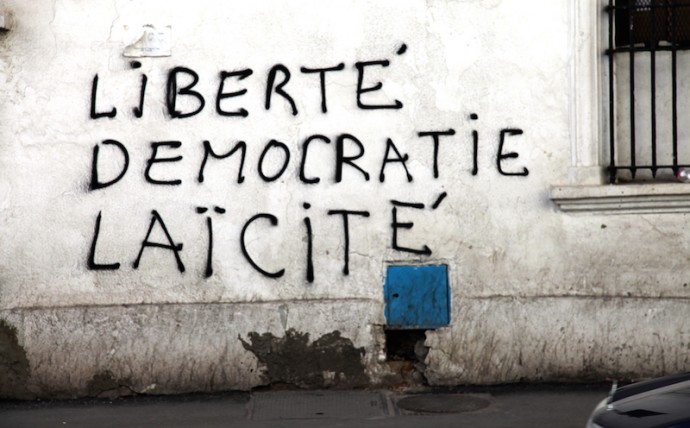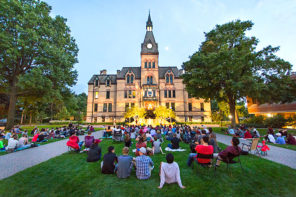After the world’s initial proclamation of solidarity with Charlie Hebdo, crystallized so effectively in #jesuischarlie, there followed a backlash among American commentators. Jacob Canfield wrote perhaps the emblematic statement of the position for Hooded Utilitarian, garnering a great deal of social media attention. In the BBC’s Stéphane Charbonnier obituary, “Charb” had been quoted as remarking, “I don’t blame Muslims for not laughing at our drawings. I live under French law. I don’t live under Koranic law.” Referring to this sentiment, Canfield described Charbonnier as a “racist asshole,” adding, “I understand that calling someone a ‘racist asshole’ after their murder is a callous thing to do, and I don’t do it lightly. This isn’t ambiguous, though.”
His assertion of the unambiguity of Charbonnier’s legacy and the magazine’s oeuvre notwithstanding, many have detailed the ways in which Canfield and others espousing similar positions have misunderstood what they see as inside jokes of French politics. But what is more helpful in understanding Charlie Hebdo’s inflammatory cartoons depicting Muhammad—along with figures central to other religions—is understanding the French notion of laïcité, and how it differs from “secularism” as it is understood in the United States.
The schoolchild’s definition of “secularism” is essentially “the separation of church and state.” The American version of this separation is bound up with the aftermath of the Wars of Religion and associated with the rise of the nation-state. It cashes out in what is called the “privatization” of religion, whereby one’s political standing is not affected by his or her religious commitments, and the accompanying norm of “toleration,” which protects (and in many cases celebrates) religious difference. As the narrative goes, once religion was politically denatured—from the comparative stability of the peace on the other side of the Wars of Religion—it became less threatening to society in general, enabling the state’s “neutrality” toward it.
The French notion of laïcité is generally translated as “secularism”; all translations are imperfect, but this one is more imperfect than most. For laïcité is derived from a different history and buttressed by different values. Before the French Revolution, political authority in France was bound up with the Catholic Church. At the convention of the Estates General, the king carried the Eucharist: just as the wafer incarnated the Son of God, implied the iconography, so too did the monarch.
In their attempt to reconfigure the political landscape of France at the end of the eighteenth century, the Revolutionaries took direct aim at the Church. The Revolution abolished the tithe, dismantled the monastic orders, and nationalized the land held by the Church in France; the Civil Constitution of the Clergy (1790) required that the clergy be elected rather than appointed and that they should swear loyalty to the French state above the Church. “Laïcité” is the french rendering of “laity,” and the Revolution’s brand of laïcité viewed its interests and those of the laity in opposition to the clergy’s. Indeed, the Revolution’s ire was directed more against the clergy than against religion: it actually attempted (unsuccessfully) to reinvent religion in France through two civil religions, the Cult of Reason and the Cult of the Supreme Being.
During France’s tumultuous nineteenth century, republicans generally endorsed the principles of the Revolution, including anti-clericalism, while monarchists typically embraced the Church, finding it—particularly with regard to its large role in the educational system—a powerful political tool. Napoleon moved to reestablish Catholicism as the state religion of France a bit more than a decade after the Revolution, in his Concordat of 1801; that same year, he told his brother, “Skillful conquerors… can both contain [priests] and use them.” It was presumably in this spirit that he moved to fund not only Catholicism but also Calvinism, Lutheranism, and Judaism in France.
Considering the history of the instrumentalization of religion in support of monarchist politics, it is unsurprising that when the Third Republic was established in 1870, it set out against the Church. The Third Republic reinstituted several of the Revolution’s church-state reforms, rolling back Napoleon’s Concordat of 1801. Ultimately it pushed even further, instituting the 1905 Law on the Separation of the Churches and State, which ended all state financial support for religion.
But the Third Republic’s legacy, in this arena, is not merely legislative: it formulated the version of laïcité that still more or less characterizes the French political imagination. This laïcité was pursued under the mantle of the Revolution’s universalist ideals: the emphasis shifted away from marginalizing the clergy (though anti-clericalism was still present) and toward creating a distinctively French identity that transcended religious difference. The center of the laicization campaign centered on education. Education had, in the hands of the republicans’ political opponents in the nineteenth century, amply proven its value for molding a French public. So the republicans set out to recast the mold, to transform education such that it would impart to French youth their universalist, rationalist ideals. (Not incidentally, this project gave rise to the oft-noted tension underwriting much of French politics: on the one hand, the commitment to principles that proclaim their own universality; on the other, the commitment to the distinctiveness of “Frenchness.”)
Laïcité has had more and less vehement articulations, over the last century—its anti-clerical guise dominated in May 1968, for instance, during the unrest that gave rise to Charlie Hebdo. More recently, some on the French right have articulated a vision of laïcité (Sarkozy called it “positive laicité”) that brings it into much closer rapprochement with American secularism. But nevertheless the two terms have different meanings, different histories, and different politics. Where secularism sprung from a sort of détente, laïcité began from an attack on entrenched power; where secularism has been bound up from the beginning with a protection of—even a celebration of—difference, laïcité has been bound up with an impulse to level difference; where secularism is associated with state “neutrality,” laïcité is associated with a state agenda for identity formation. (Thus Charlie’s editor-in-chief Gérard Biard said, when interviewed in the fallout of controversial cartoons published two years ago, “You’re not meant to identify yourself through a religion, in any case not in a secular state.”)
In recent years, the divergence between “secularism” and “laïcité” has been legible in the discourse around the headscarf controversy. Americans are often mystified by the French impulse to abridge “personal liberties,” since “freedom to” liberties loom large in the narrative justifying secularism. But such liberties that are evoked in justification of laïcité are “freedom from” liberties: in the same Times interview, Biard expressed concern about the manipulation of French people (and particularly Muslims) by religious leaders. Similarly, where the “private” nature of religion under secularism signals that its expression is protected from government interference, the “private” nature of religion under laïcité signals that it is to be distinguished from res publica—and taken out of public space on these grounds.
Without discounting French racism—which is undoubtedly a very grave problem—I would suggest that such racism does not cast much light on Charbonnier’s statement, “I live under French law. I don’t live under Koranic law.” Rather, it is in the tradition of laïcité—and specifically laïcité, with its anticlerical character and its unstable marriage of universalist aspirations and French distinctiveness—that we should situate his claim.





